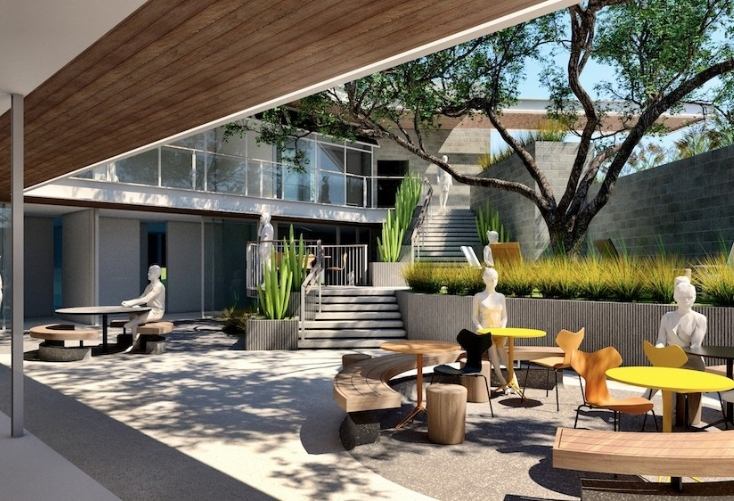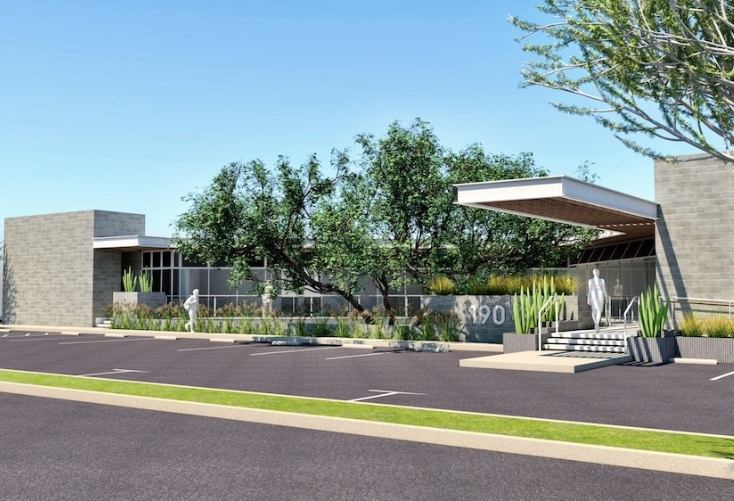- If you’re familiar with the term ‘work-life balance’, it won’t surprise you to know that workspace design frequently borrows ideas from the multifamily world.
- Innovative companies recognize that enhancing the appeal of the office will attract employees back to the physical workplace, and help attract new talent, too.
- From outdoor work areas to indoor ‘sanctuary’ spaces, there is much that office designers can learn from multifamily buildings, which ultimately improves workers’ comfort and well-being.
This article was written by Ancelmo Perez, and was originally published on Work Design Magazine.
Various sectors of real estate often draw from one another for inspiration. One example is how the tenets of today’s multifamily design are leading the progressive movement of what people desire—and increasingly demand—in the office.
Many employers continue to struggle with recruitment, especially when it comes to bringing their teams back to the office. Having become accustomed to a greater work-life balance and flexible schedule, employees need a greater “why” if they are going to make the trip back. For innovative companies, enhancing the appeal of the office space will not only attract employees back to the physical workplace, but will attract new talent as well.
Architects and designers must meditate on creative concepts and ideas that will ultimately be pivotal to the success of the post-pandemic office space.
What is it that people want when they go to work?
What need can the office fulfill that remote work simply can’t compete with?
How can designers emulate the comforts of home into an improved-upon workplace—something that is more than just an office?
These are just a few of questions that architects and designers consider on a daily basis.
When crafting office space, designers can draw inspiration from the cutting-edge improvements of multifamily design. As multifamily buildings constantly evolve to attract tenants and increase comfort, they have innovated at a remarkable pace. Moreover, the pandemic expedited the trend of providing more than comfort. Beyond this standard, multifamily design seeks to provide an empowering and community-oriented lifestyle —one that lifts people up and gives them everything they need either at their fingertips or within walking distance.
As architects, we can draw from the innovations of multifamily and infuse these new design practices into the office space.
An Outdoor Eden with an Indoor Sanctuary
Intentionally designed outdoor areas serve as a primary draw for return-to-the-office recruitments.
Over the years, studies have continued to reveal cognitive and mood-boosting benefits of spending time outdoors and among nature. In 2019, a study by APM Research Lab found that work-related factors were the most common reason cited by Americans for why they do not spend time in nature.
Today, tech-fatigue and tech-induced anxiety is nearly endemic to our population. People crave a break from the constant interruptions and overload of information that comes with technology.
The solution for greater piece?
Design that blends the tranquility and expanse of the outdoors with the shelter and safety of the indoors.
According to the National Association of Home Builders, 36% of multifamily developers are building green projects; that number is projected to increase to 47 percent by the end of 2022. The common thread between these green projects is the goal of boosting natural light and ventilation through prioritization of outdoor and communal spaces—such as community garden terraces with charming string lights and individual balconies in each unit.
In contrast to years past, where most architects were directed by developers to sacrifice individual and communal outdoor space for the sake of maximizing density and leasable area, we are now seeing developers demand design where outdoor space is prioritized over leasable surface area.
Office owners and tenants that are smart and want to stay relevant, will adopt this principal, and invest in quality outdoor space.
Throughout multifamily, additional efforts enhance these new outdoor spaces with furniture, dining space, attractive landscaping, and accessible Wi-Fi. These simple considerations are easy to incorporate into design blueprints, but they yield an enormous difference in renter satisfaction.

Another outdoor amenity that greatly boosts tenant satisfaction, especially in heavily urban areas, are community gardens. According to research, community gardens break cultural barriers and foster friendships with neighbors, therefore increasing length of stay and tenant retention. The community garden can be applied and transitioned to the new office space as well. If there’s an area of lush greenery at work, people are more likely to build relationships, be happier and more productive, and stay longer with their company.
Since the pandemic, people crave sanctuaries from the stress and hustle of life. At our current junction point, the home represents that sanctuary, but workplaces can achieve these elements of “a sanctuary” too, rather than a space that condones stress, boredom, etc. Through design, environments are transformed. It is possible that in the not-so-distant future, no one will even remember the days of the cubicle. One of our current projects emulates this idea of the sanctuary; we drew heavily from the coastal, mid-century modern home style. The entry point is a key part of this, as we aim for the moment of arrival to be reminiscent of pulling up to and entering an elegant home.
The greater outdoors also gives workers the ability to be productive outside for periods of time, play games with fellow employees, and embrace movement and passive exercise in increments throughout the day. In fact, studies have shown that “sit less, move more” workplaces foster a 72% improvement in time management and completed workload. This is groundbreaking news and should not be taken lightly, and as designers, we value creating spaces that encourage greater productivity and creativity as the two are synonymous.
Another project we’re working on is an office redevelopment in Southern California. Our goal lies in establishing a true indoor-outdoor experience. We’re achieving this through incorporating a courtyard with intentional flows, a terracing staircase, and high visibility between the outdoors and the indoor office spaces. Utilizing playful landscaping and varied furniture and seating configurations further enhances the user agency, engagement, and comfort.
Co-Living, Coworking, & In-House Entertainment
A tide-changing design trend we’re seeing as designer lies in the increase of co-living spaces within multifamily developments. As the price of living continues to exponentially increase, many young professionals are seeking a new way to live.
This emphasis on community over individuality can lend itself into the office sphere. People, especially young people in the beginning stages of their career, want social connections and networking to come naturally—along with innovation and learning. Remote work has a finite cap on networking and collaboration. By making the office a cosmopolitan space, where exchange of ideas constantly flow, employers will attract professionals back.
Additionally, a well-designed office that incorporates experiential amenities and common areas communicate to employees that their organization cares about their well-being and future career success.
For housing developments, design elements that embody the culture of the community are a meaningful way to connect with tenants and make them feel both comfortable and represented in a space. Multifamily communities are increasingly diversifying and becoming true hubs for residents. This can be established through building architecture, artwork, and other amenities that reflect the culture of the urban area.
This concept can also be honored in the office space, incorporating an employee-centered look into the company that helps to add personal touches where employees feel represented in the design.
Further, the entry experience in any workplace is equally as important nowadays as it is for a multifamily community. Similarly, companies must create a powerful first impression to recruit top talent and grow retention rates. Every successful company must have energy, clarity, and personality that’s instantly recognizable—and these qualities can be funneled into and embodied by the office.

The Office is a Sales Pitch: Know, Like, Trust
Similar to multifamily, the office post-2020 must be more about creating a community around a brand or aesthetic. Just as consumers want to associate with brands and housing experiences that pair nicely with their values—or for younger generations, their “aesthetic”—the same concept applies to the office.
People like living in immediately recognizable, easy-to-find apartment communities, achieved through strong exteriors, branding, incorporation with surrounding amenities, and moving forward, this should apply to office building and complexes as well.
In addition, the office space itself should embody the brand of each company, heightening their messaging and utilizing the office as a conduit to attract the best and brightest talent.
While this concept has been incorporated into multifamily spaces for years, we are observing an influx of companies incorporating design elements, signage, and color palettes that promote company brand throughout their office spaces—whether they own the entire building or lease a small portion of it.
For instance, we are highly intentional with the placement and materials of signage on both the exterior and interior of our office projects. In order to gain the trust of employees, we are also shifting the design of offices to the polar opposite of the cubicle, but flexible and wide-open spaces. The idea is similar to that of an apartment ground-level or hotel lobby, where you are encouraged to relax, be curious, and delight in the sensory beauty of the open floor.
Just like any good brand creates a strong and positive perception of a company, the brand of the office can do the same. It must feel inviting, cheerful, and safe from a design layout in order to set the foundation for further success.
A Conscious Awakening Across CRE Design
As multifamily community designs have become more comfortable, flexible, and conducive to supporting practical and emotional needs, and thus more attractive to tenants, we believe this can be applied to the office.
Today, the office space will be anything but stagnant in its services and appearance. The workplace is no longer the dismal, uncolored landscape.
Similar to how multifamily communities have shifted away from the dull, transactional nature of how they looked an operated before, the office is becoming much more than a place people simply go to “check out” or work unconsciously, but is instead where people go to connect, innovate, and collaborate.


 Dr. Gleb Tsipursky – The Office Whisperer
Dr. Gleb Tsipursky – The Office Whisperer Nirit Cohen – WorkFutures
Nirit Cohen – WorkFutures Angela Howard – Culture Expert
Angela Howard – Culture Expert Drew Jones – Design & Innovation
Drew Jones – Design & Innovation Jonathan Price – CRE & Flex Expert
Jonathan Price – CRE & Flex Expert














